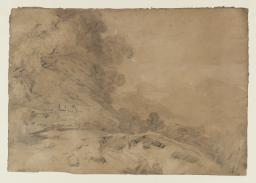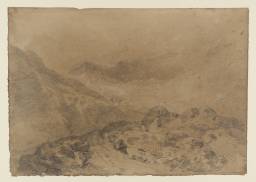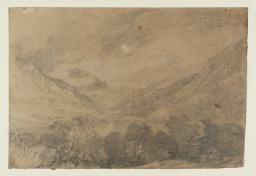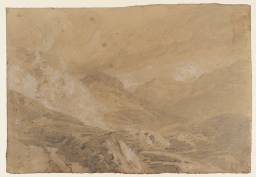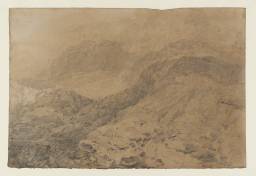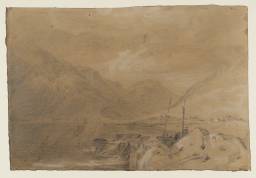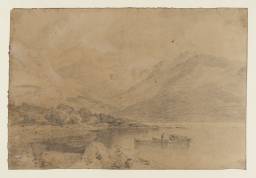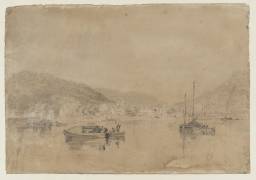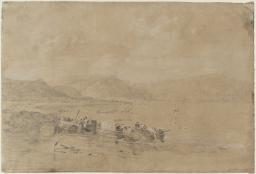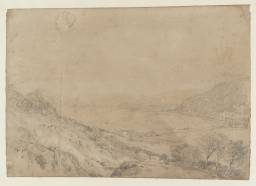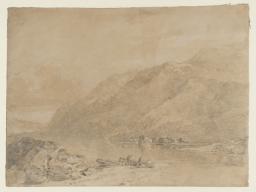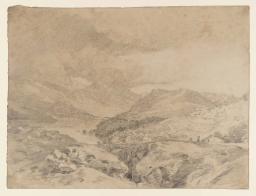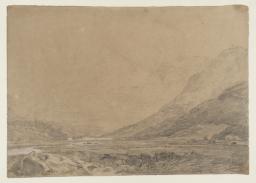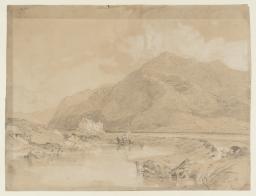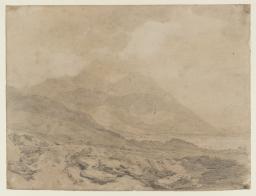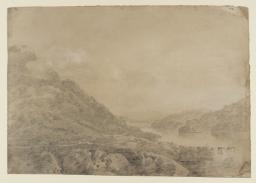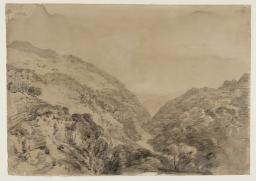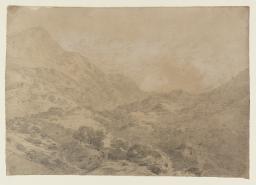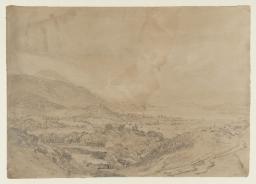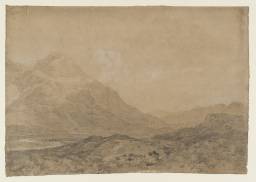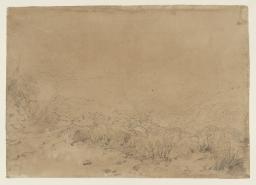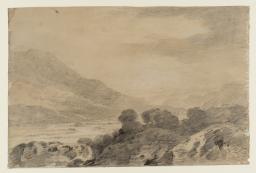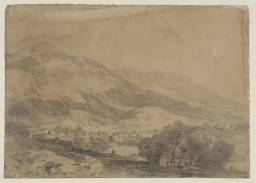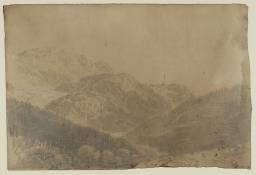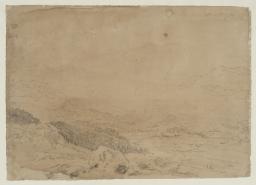Turner Bequest LVIII 1–42, 44–60, LXXX A
References
Turner reported to the artist Joseph Farington (1747–1821) that he washed all these sheets of paper with a concoction of ‘India Ink and Tobacco water’ and used ‘liquid white of his own preparing’ for the highlights;1 the backs are also washed with this buff mixture, though they are only occasionally drawn on. A large number of these ‘Scottish Pencil’ subjects, as John Ruskin dubbed them,2 were noted in either the 1801 Scotch Lakes or Tummel Bridge sketchbooks (Tate; Turner Bequest LVI, LVII), and it is remarkable that they are often based on the slightest of outlines. But it is clear from other drawings in the series which do not rely on notes in sketchbooks that he was working in these media while actually on tour in Scotland (see for example D03412 and D03413; Turner Bequest LVIII 33, 34); rain spots on D03427 (Turner Bequest LVIII 48) testify to his having worked in this manner out of doors. It is likely that he went out on excursions from the inns where he stayed, making groups of drawings in different locations nearby.
The subjects may be considered, as far as they can be identified, in a sequence following Turner’s route through the Highlands, which may not correspond with the order in which he executed them; see the concordance in the technical notes below. Some suggestions as to locations have been offered on the evidence of apparent afforestation, indicating the radical improvements made by the 4th Duke of Atholl who in the later eighteenth century planted hundreds of thousands of larches and other softwoods, transforming the appearance of the formerly bleak landscapes of the Tummel, the Tilt, the Garry and the Tay. See D03412 and D03413 (Turner Bequest LVIII 33, 34).
Turner was clearly pleased with the results, and showed the drawings to his colleagues at the Royal Academy, for according to Farington they were ‘much approved’; Farington had enthused about the landscapes of Edinburgh after his visit there in 1788, and Turner reciprocated with his opinion that Scotland was ‘a more picturesque contry [sic] to study in than Wales’.3
Many commentators have been puzzled by this series of drawings, executed in monochrome, usually pencil and white gouache with occasional use of charcoal, on paper washed a darkish grey–buff: they seem to contradict Turner’s awakening sense of the power of light and colour, apparent in other work of the years round the turn of the century. Ruskin, who thought them dull, also described them as ‘scientific in the extreme’.4 In fact, the mountain scenery may well have prompted Turner to experiment with a slatey, rain–pervaded palette rather as his tour of the Rhine in 1817 was to do: that resulted in a set of fifty drawings, all executed in watercolour and gouache on grey–washed paper.5 The present author has suggested that, while recording his experiences in Scotland as precisely as possible, he was also deliberately paying tribute to the monochrome views in Italy that Richard Wilson (1713–1782) had made in black and white chalk on grey paper for the Earl of Dartmouth in the 1750s.6 Compare Turner’s use of coloured grounds in his Wilson sketchbook of 1796–7 (Tate; Turner Bequest XXXVII).
Whether or not they were begun on the spot or completed some time later, for consistency the sheets are all dated here to 1801 without further qualification.
Entry for 6 February 1802, Kenneth Garlick and Angus Macintyre eds., The Diary of Joseph Farington, vol.V, New Haven and London 1979, p.1742.
Entry for 6 February 1802, Garlick and Macintyre 1979, p.1742; for comment on this judgement see Wilton 1982, pp.14–15.
Technical notes
The sheets were recorded by Finberg as originally:
mounted on the pages of a large folio book (23 ¼ x 17 ½), with heavy leather covers, handsomely tooled, inscribed in gold lettering – “Italiaanse Tekeningen.”
On top–right corner of first page is written in ink [not in Turner’s hand] “60” and “68”; also “Lot 8.”
Inside the front cover is written in ink, “61 Leaves,” in what may be Turner’s handwriting. Also, in pencil:
“St. Helen’s Church.
Abingdon
... (?)
on the right hand of the road to
London .”
Abingdon
... (?)
on the right hand of the road to
London .”
Generally the leaves on which the drawings were mounted have been cut out, but in some cases the drawings, which were only stuck at the four corners, have been taken off. On these pages, in what would have been the margins of the drawings, a number of initials have been placed. Among these are – “S.W.P.” (three times), “W.F.W.”, “Ed.,” “F.,” and “E.D.”
On the narrow slip that remains of one of the pages cut out, Turner has written in pencil:–
Finberg noted that John Ruskin made up a parcel of 37 of the sheets, labelling it ‘AB. 290. P.R.’, and endorsing the contents: ‘37 Scottish Pencils. Of very great value. Too large for mounting or exhibiting till there is more room.’11
When the Turner Bequest works were transferred to the British Museum following the 1928 Tate Gallery flood, some of the drawings were mounted in a specially made hardback album (now emptied and preserved at Tate Britain), with a pencil note inside its cover by curator Arthur Magyer Hind:
LVIII Scottish Pencils
Bound 1935, including the following thirty six leaves
1, 2, 9, 12, 13, 15–19, 21–25, 28, 30–33, 37–40, 44, 47– 9, 51–55, 58–60
The rest mounted
A.M.H.
Bound 1935, including the following thirty six leaves
1, 2, 9, 12, 13, 15–19, 21–25, 28, 30–33, 37–40, 44, 47– 9, 51–55, 58–60
The rest mounted
A.M.H.
Of the ‘Scottish Pencils’ catalogued as such by Finberg,12 Tate D03422 (Turner Bequest LVIII 43) has since been recognized as a Welsh subject of 1798. Conversely, Tate D04894 (Turner Bequest LXXX A), once considered an Alpine view, has been included here. As discussed above, a notional concordance follows, grouping the subjects in the order in which Turner would have encountered the identified locations on the 1801 tour.
</b> | <b>Tate | Turner Bequest | Subject |
| 1 | D03435 | LVIII 56 | (pines, valley, loch and graveyard) |
| 2 | D03380 | LVIII 1 | Loch Lomond and Ben Lomond |
| 3 | D03427 | LVIII 48 | (mountains with sheep) |
| 4 | D03425 | LVIII 46 | ?Loch Lomond |
| 5 | D03382 | LVIII 3 | ?Loch Lomond |
| 6 | D03393 | LVIII 14 | ?Loch Lomond and Ben Lomond |
| 7 | D03426 | LVIII 47 | ?Loch Lomond |
| 8 | D03430 | LVIII 51 | Near Loch Long, with Ben Arthur |
| 9 | D03381 | LVIII 2 | Glen Croe and Ben Arthur |
| 10 | D03383 | LVIII 4 | ?Pass of Glen Croe |
| 11 | D03400 | LVIII 21 | ?Glen Dochart and Ben More |
| 12 | D03384 | LVIII 5 | ?Ben Arthur |
| 13 | D03386 | LVIII 7 | Loch Fyne |
| 14 | D03387 | LVIII 8 | Loch Fyne |
| 15 | D03388 | LVIII 9 | Inveraray Castle and Duniquoich Hill |
| 16 | D03389 | LVIII 10 | Inveraray |
| 17 | D03390 | LVIII 11 | Loch Fyne and Inveraray |
| 18 | D03391 | LVIII 12 | Glen Shira, Loch Fyne and Inveraray |
| 19 | D03439 | LVIII 60 | Ben Cruachan and Loch Awe |
| 20 | D03392 | LVIII 13 | Inishail in Loch Awe, and Ben Cruachan |
| 21 | D03394 | LVIII 15 | Loch Awe and Ben Cruachan |
| 22 | D03395 | LVIII 16 | Kilchurn Castle, River Orchy and Ben Cruachan |
| 23 | D03396 | LVIII 17 | Cruachan Arain, Ben A’an and Ben More |
| 24 | D03397 | LVIII 18 | Ben More and Glen Dochart |
| 25 | D03398 | LVIII 19 | Ben More, Loch Dochart and Castle Dochart |
| 26 | D03402 | LVIII 23 | Ben More and Glen Dochart |
| 27 | D03406 | LVIII 27 | Ben More and Glen Dochart |
| 28 | D03414 | LVIII 35 | ?Glen Dochart |
| 29 | D03421 | LVIII 42 | Killin and Meall nan Tarmachan |
| 30 | D03420 | LVIII 41 | Killin and Meall nan Tarmachan |
| 31 | D03401 | LVIII 22 | Loch Tay |
| 32 | D03399 | LVIII 20 | ?Glen Lyon |
| 33 | D03417 | LVIII 38 | ?Schiehallion |
| 33 verso | D41441 | – | Tummel Bridge |
| 34 | D03385 | LVIII 6 | ?Valley of the Tummel |
| 34 verso | D40261 | – | (a hillside) |
| 35 | D03418 | LVIII 39 | Tummel Bridge |
| 36 | D03419 | LVIII 40 | Tummel Bridge |
| 37 | D03411 | LVIII 32 | ?Loch Tummel |
| 38 | D03404 | LVIII 25 | Pass of Killicrankie |
| 39 | D03438 | LVIII 59 | ?Blair Atholl |
| 40 | D03412 | LVIII 33 | Glen Bruar |
| 41 | D03413 | LVIII 34 | Glen Bruar |
| 42 | D03405 | LVIII 26 | Ben y Vrackie |
| 43 | D03415 | LVIII 36 | ?Killiecrankie |
| 44 | D03416 | LVIII 37 | Ben y Vrackie |
| 45 | D03407 | LVIII 28 | village ?near Pitlochry |
| 46 | D03403 | LVIII 24 | (road, river valley and mountains) |
| 47 | D03436 | LVIII 57 | ?River Tay near Dunkeld |
| 48 | D03408 | LVIII 29 | mountains near Dunkeld |
| 49 | D03424 | LVIII 45 | ?Dunkeld House and River Tay |
| 50 | D03434 | LVIII 55 | ?Glen Almond near Newton Bridge |
| 51 | D03409 | LVIII 30 | Vale of Earn |
| 52 | D03423 | LVIII 44 | Vale of Earn |
| 53 | D03410 | LVIII 31 | ?Vale of Earn |
| 54 | D03433 | LVIII 54 | (mountains) |
| 55 | D03432 | LVIII 53 | (mountains and lake) |
| 56 | D03428 | LVIII 49 | (silver birch stems, rocks and foliage) |
| 56 verso | D41442 | – | (?rocks and foliage) |
| 57 | D03429 | LVIII 50 | (rocks and foliage) |
| 58 | D03431 | LVIII 52 | (rocks under a river bank) |
| 59 | D03437 | LVIII 58 | (rocky cliff) |
| [60] | D04894 | LXXX A | Ben Lomond from Luss |
How to cite
Andrew Wilton, ‘The ‘Scottish Pencils’ 1801’, subset, May 2013, revised by Matthew Imms, April 2015, in David Blayney Brown (ed.), J.M.W. Turner: Sketchbooks, Drawings and Watercolours, Tate Research Publication, April 2016, https://www

